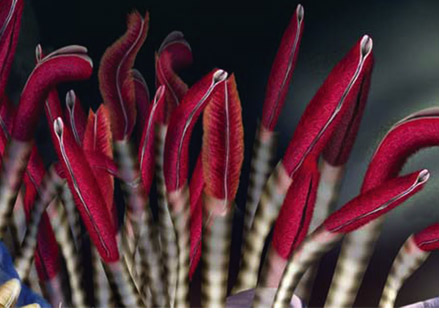


Not Your Average Sea World
by Carole VanSickle

![]()
Listening to the Earth from Under the Sea
Imagine yourself 2,200 meters below the surface of the ocean with your feet in 400-degree-Celsius water and your head in nearly freezing temperatures. You have no mouth, no stomach and no means of expelling waste. And the environment in which you’re immersed has higher concentrations of heavy metals and acidic compounds than any other water body on earth. It’s not a likely place for a Club Med vacation, but a touch of heaven if you’re a tubeworm, a giant clam or any of the other 300 or so uniquely adapted species that live around hydrothermal vents.
Named for the super-hot water they spew, hydrothermal vents are cracks in the Earth’s crust where cold ocean water and the molten inner layers of the planet come together. The result is a rapid set of physical and chemical reactions that produce vast amounts of energy, which the local microbes then adeptly use for sustenance.

The tubeworms that cluster around this hydrothermal vent have no mouth, no stomach and no means for expelling waste. Scientists theorize that bacteria in the tubeworms’ primitive guts process the minerals that the worms absorb from the vent water, thereby sustaining both creatures. Tubeworms can grow to be 1.5 meters long and 2 centimeters in diameter.
Because of the utter absence of sunlight, no plants can exist at these depths. Animals adapted to this environment, however, thrive. Some of them are hosts: The tubeworm, for example, houses up to 285 million bacteria and subsists on their metabolic waste products. Other vent denizens are predators: The blind Atlantic vent shrimp, for example, feed directly on bacteria. The leggy spider crabs eat shrimp. Tubeworms can grow up to four feet in length, while giant clams can be as large as dinner plates.
One reason for this apparent prosperity is innovation. Predators like the viperfish and deep-sea anglerfish have evolved ingenious ways to attract their prey in the darkness. Both species have phosphorescent appendages that serve as fishing lures and attract smaller fish and other prey. Vent creatures, being products of extremes — extreme temperatures, extreme pressures and extreme isolation — also sport some extreme anatomies. They have no lungs, no guts and no bladders, for instance, because the extreme pressure of the water would cause air pockets anywhere in their bodies to “pop.” There are even “naked” snails around the vents. They do not form calcium carbonate shells because of the highly acidic water and yet exist in relative safety by living very close to the actual crack in the crust, in the most acidic waters of the vent community.
The ecosystems created by hydrothermal vents are not merely extreme but old — extremely old. “Many scientists think that vent systems may be one of the best indicators of the origins of life on earth,” said Daniela Di Iorio, an oceanographer at the University of Georgia. “Everything down there now could have existed when the planet was nothing but water and molten rock and then evolved as the planet cooled and stabilized.
“It’s hard to look at a tubeworm and see it as an ancient relative,” Di Iorio added, “but the discovery of hydrothermal vents very likely set in motion a paradigm shift that will enable us to learn a great deal more about the building blocks that brought life toward where we are today.”
-CV
For comments or for information please e-mail: rcomm@uga.edu
To contact the webmaster please email: ovprweb@uga.edu
![]()